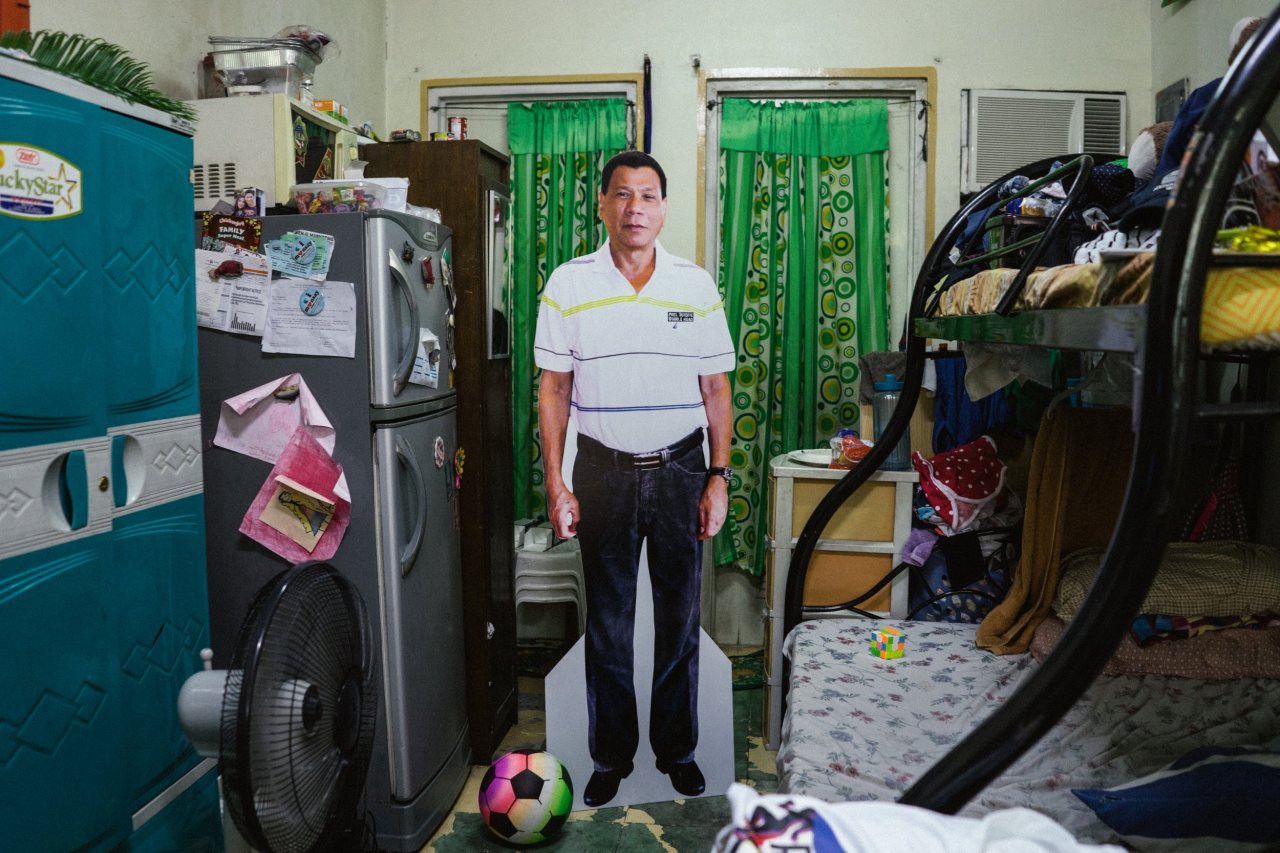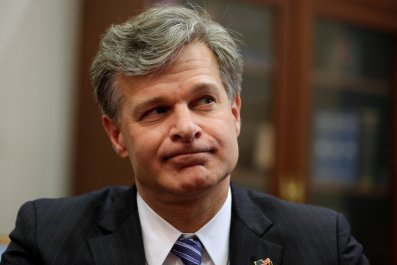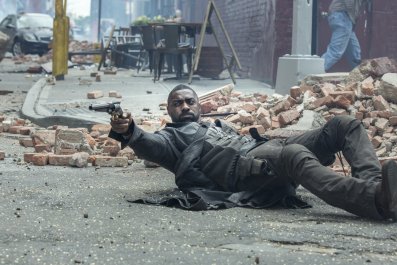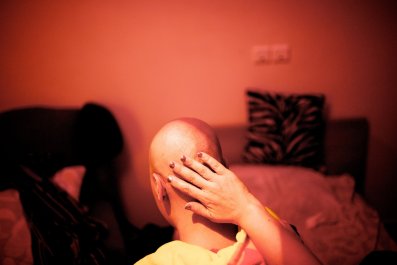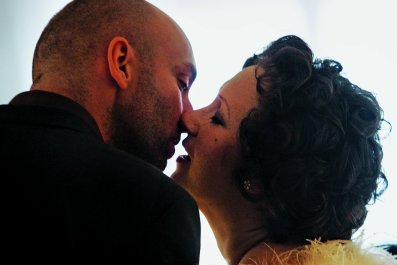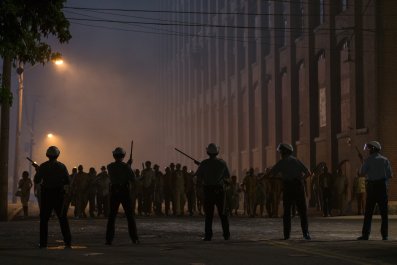At a café in Baguio City, Philippines, on the island of Luzon, Mary Lou Marigza's voice trembles as she recounts her experience as a political detainee under then-dictator Ferdinand Marcos, who imposed martial law in the Philippines from 1972 until 1981. Marigza was tortured, mostly by electrocution, for 13 months for organizing anti-government protests.
When the current Philippine president, Rodrigo Duterte, declared martial law on the southern island of Mindanao in May, it brought Marigza back to her time in detention. Like many in the Philippines, she believes Duterte may extend military rule nationwide, and fears the return of Marcos-era abuses. Already, Duterte has threatened to jail martial law critics and dismiss Supreme Court verdicts that challenge his authority.
Marigza is dismayed by the public's meek response since martial law began on Mindanao, which is home to nearly a quarter of the country's population. "Duterte is still a popular president," she says. "And the reaction of the public after the declaration is so poor. There's not even panic or concern. It seems like it's just our destiny."
Not every Filipino feels the same way about martial law or Duterte. Nearly 30 years after Marcos's death, a powerful propaganda campaign by the Marcos family and its allies has twisted many Filipinos' views on history, causing them to see life under Marcos as a kind of "golden age" for the Philippines. That's good for the Marcos family, and makes it easier for many to accept a similar authoritarian government under Duterte. Fifty-seven percent of Filipinos support Duterte's declaration, according to a Social Weather Stations survey in June. Duterte polls even better: According to another recent SWS survey, 78 percent of Filipinos are satisfied with him.
In early July, the Philippines Supreme Court upheld Duterte's imposition of martial law in Mindanao, ending any claims opposition parties had over its constitutionality. The president's allies, who have a majority in Congress, overwhelmingly support martial law. Though opposition groups have organized anti–martial law rallies, mostly in Manila, they have done little to threaten Duterte's agenda.
Duterte's announcement came on May 23, after pro-ISIS rebels from the Maute group, a local band of radical jihadists, raided Marawi, Mindanao's predominantly Muslim city of 200,000. The Philippine government says it failed in an attempt to capture Isnilon Hapilon, the leader of the Abu Sayyaf group (a Maute ally) and one of the U.S. State Department's most wanted terrorists believed to be hiding out in the city. In retaliation, Maute militants opened fire on government forces, burned local schools and the city jail, and they held a priest and about a dozen churchgoers hostage.
Since that botched raid, the Philippine military, along with U.S. special forces, has been battling the militants by bombing Marawi and surrounding areas and killing hundreds of rebels. According to the Duterte administration, the rebels have killed dozens of civilians and government soldiers. The conflict has displaced nearly 400,000 people, and more than 70,000 people are living in government-run evacuation centers.
With the declaration, the military now has sweeping powers in Mindanao, including the authority to detain people without a warrant, implement curfews (as early as 9 p.m. in some areas), and monitor those traveling within the island. Martial law is not allowed to supersede the functioning of civil courts, Congress or the Constitution, but critics fear Duterte will use martial law to establish an authoritarian regime similar to that of the late dictator Marcos. New York–based Human Rights Watch has said martial law, "threatens to widen the scope of abuses under [Duterte]," who, for example, has joked that he would exonerate soldiers who commit rape in Mindanao. Duterte was elected a year ago on promises to eradicate illegal drugs and reduce crime by killing drug users and dealers. Since his election, local media and human rights groups estimate that more than 7,000 people have been killed by police and vigilantes, creating fear among Duterte's critics that his version of martial law could become similarly extreme.
Duterte's spokespeople say martial law is necessary to protect national security, and they have repeatedly called for unity during the crisis and promised that the military would be kept in check.
The Philippine Constitution limits the martial law declaration to just 60 days, which ends on July 22, but Congress can vote to extend it. When asked earlier in July whether he would lift the declaration, Duterte said he would not as long as the situation in Marawi remains "critical." Pantaleon Alvarez, the speaker of the House of Representatives and a Duterte ally, suggested he would push his colleagues to support extending the declaration for the remainder of Duterte's presidency, which ends in 2022.
Duterte has also threatened to impose martial law nationwide. "If that rebellion burns Mindanao and the other parts of the Philippines and I will be forced to declare martial law again, this time I will do it on my own to preserve my nation," Duterte said in June. "I will not consult anybody, and there is no telling when it will end."
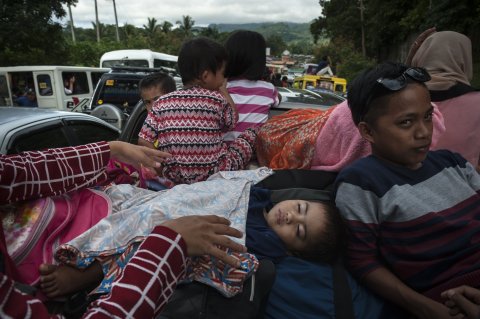
Many here believe Filipino support for martial law is the result of a skilled propaganda campaign by the Marcos family and its supporters about martial law under President Marcos in the '70s and '80s, which was imposed in response to a Communist insurgency. During that period, military forces killed at least 3,240 people, tortured 34,000, and imprisoned 70,000, according to Amnesty International. After mass civilian protests and military defection forced Marcos into exile in Hawaii in 1986, a commission established by a democratically elected president recovered less than $4 billion of the estimated $10 billion the Marcos family allegedly plundered from state coffers.
There is no mention of human rights violations or stolen money at the World Peace Center in Ilocos Norte, a public photography gallery in Ferdinand's hometown of Batac that memorializes him and his wife Imelda. An inscription over the door reads: "President Marcos respected the rule of law during the period of martial law, ensured due process of law and the protection of human rights.… He did not implement [the] death penalty to a Filipino during and after martial law." Three other museums nearby—the Ferdinand E. Marcos Presidential Center, the Malacanang of the North, and the Marcos Museum—are mum on the subjects as well.
Instead, these museums do little but flatter Marcos. An exhibit detailing Marcos's fighting against the Japanese in World War II claims he narrowly escaped death eight times. Another story tells of the time when young Andy (his childhood nickname) told his friend to stop killing ants because "just like everyone else they too deserve the right to live."
The Marcoses have amassed a cult-like following in Ilocos Norte, his home province. Three life-sized cutouts of Imelda, Imee (their eldest daughter and the current governor of Ilocos Norte) and Bongbong (their only son) welcome visitors at the provincial capitol building in Laoag. Every September, a birthday bash—featuring singing contests, debate competitions and free tours of museums—praising Marcos is held in his honor. "[Ilocanos] feel that because he has brought a lot to the province and given his entire life for the country, it's proper to repay him," says Ilocos Norte Information Officer Jun Gudoy.
That propaganda—and various prominent infrastructure projects developed under Marcos in Manila, like the Cultural Center of the Philippines and the Philippine Heart Center, which critics say he used to enrich himself—have made many in Ilocos Norte revere Marcos. "People are saying that the Filipino people were more disciplined [under Marcos], so we want martial law [again]," says Joselito Lolinco, a retired teacher and longtime resident of the province.
Others say that, in addition to propaganda, support for Marcos across the country stems from the failure of subsequent governments to live up to the promises of democracy, causing many Filipinos to question what it can do for them. After Marcos, Filipinos "didn't really see a significant change in government," said Tin Alvarez, a spokeswoman for Block Marcos, an anti-Marcos group in Manila. "There's still corruption, extreme poverty and inequality. All the basic dignities of life that were violated under Marcos, the same conditions persist in a liberal democracy." The Philippines is one of the fastest-growing economies in Southeast Asia, yet poverty and corruption remain endemic. According to the Asian Development Bank, 21.6 percent of Filipinos live below the national poverty line. Transparency International rates the Philippines 101st out of 176 countries on the 2016 Corruption Index list.
This has created some nostalgia for Marcos among Filipinos, many of whom are convinced that martial law could be used to address the country's systemic problems. "If we keep focusing on Marcos's negatives rather than his positive contributions, then we will keep dividing this nation," says James Ventura, a Marcos supporter and leader of the National Youth Commission in Ilocos Norte. Martial law, he added, is sometimes necessary: "It's like "a father scolding his son." Many Filipinos agree. According to a Pulse Asia survey in March, 20 percent of Filipinos said that "it may be necessary now to have martial law to solve the many crises of the nation." Support is highest in the Visayas region, one of the three main island groups in the Philippines, where 36 percent agree.
Though the propaganda and enthusiasm for Marcos is strongest in Ilocos Norte, a neutral—or even positive—portrayal of Marcos exists in the rest of the Philippines, especially in schools. "A lot of high school textbooks do it like accounting. Here's debit; here's credit. If you look at the good things and the bad things Marcos did, apparently the net is he still turns out OK," said Jose Tirol, a history professor at Ateneo de Manila University who developed a martial law course for his university last year.
Last year, Bongbong Marcos, a former senator, campaigned for the vice presidency of the Philippines, bringing Marcos propaganda from the fringes of political discourse into the mainstream. In one example, a Marcos supporter shared a conspiracy theory on Facebook in February 2016 accusing Ninoy Aquino, one of Marcos's former archrivals, of fomenting political unrest in the country to force Marcos to declare martial law. The post, entitled "Understanding Martial Law," is just one of the thousands made on social media during the election to revise history and repair the Marcos name. (Bongbong, a Duterte ally, lost to the Liberal Party candidate by 263,000 votes and is contesting the results before the Supreme Court. )The Marcoses, meanwhile, continue to profess innocence against accusations of human rights violations, plunder and corruption—although lawsuits are still pending in the Philippines today. Imee and Bongbong did not respond to repeated requests for comment.
Duterte has lauded Ferdinand Marcos, and cites him as an inspiration. In June, after he had threatened to expand martial law across the Philippines, he called the possibility "a copycat of Marcos." That concerns Marigza, the former political detainee. "I imagine a future in which we will have to go through another cycle of unrest and internal dispute over a political lesson that should have already been learned," Marigza said. But she says she is trying to remain optimistic: "I also have faith that [Filipinos] eventually won't stand for it."



